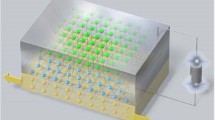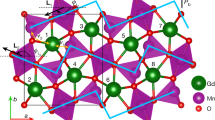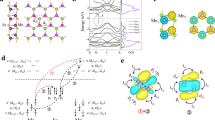Abstract
Magnetoelectric systems could be used to develop magnetoelectric random access memory and microsensor devices. One promising system is the two-phase 3-1-type multiferroic nanocomposite in which a one-dimensional magnetic column is embedded in a three-dimensional ferroelectric matrix. However, it suffers from a number of limitations including unwanted leakage currents and the need for biasing with a magnetic field. Here we show that the addition of an antiferromagnet to a 3-1-type multiferroic nanocomposite can lead to a large, self-biased magnetoelectric effect at room temperature. Our three-phase system is composed of a ferroelectric Na0.5Bi0.5TiO3 matrix in which ferrimagnetic NiFe2O4 nanocolumns coated with antiferromagnetic p-type NiO are embedded. This system, which is self-assembled, exhibits a magnetoelectric coefficient of up to 1.38 × 10–9 s m–1, which is large enough to switch the magnetic anisotropy from the easy axis (Keff = 0.91 × 104 J m–3) to the easy plane (Keff = –1.65 × 104 J m–3).
This is a preview of subscription content, access via your institution
Access options
Access Nature and 54 other Nature Portfolio journals
Get Nature+, our best-value online-access subscription
$29.99 / 30 days
cancel any time
Subscribe to this journal
Receive 12 digital issues and online access to articles
$119.00 per year
only $9.92 per issue
Buy this article
- Purchase on Springer Link
- Instant access to full article PDF
Prices may be subject to local taxes which are calculated during checkout






Similar content being viewed by others
Data availability
The data that support the plots within this paper and other findings of this study are available from the corresponding authors upon reasonable request.
Change history
09 June 2021
A Correction to this paper has been published: https://doi.org/10.1038/s41928-021-00609-6
References
Ramesh, R. & Spaldin, N. A. Multiferroics: progress and prospects in thin films. Nat. Mater. 6, 21–29 (2007).
Spaldin, N. A. & Ramesh, R. Advances in magnetoelectric multiferroics. Nat. Mater. 18, 203–212 (2019).
Wang, K. L., Lee, H. & Amiri, P. K. Magnetoelectric random access memory-based circuit design by using voltage-controlled magnetic anisotropy in magnetic tunnel junctions. IEEE Trans. Nanotechnol. 14, 992–997 (2015).
Hill, N. A. Why are there so few magnetic ferroelectrics? J. Phys. Chem. B 104, 6694–6709 (2000).
Vaz, C. A. F., Hoffman, J., Ahn, C. H. & Ramesh, R. Magnetoelectric coupling effects in multiferroic complex oxide composite structures. Adv. Mater. 22, 2900–2918 (2010).
Chen, A., Su, Q., Han, H., Enriquez, E. & Jia, Q. Metal oxide nanocomposites: a perspective from strain, defect, and interface. Adv. Mater. 31, 1803241 (2019).
Zheng, H. et al. Multiferroic BaTiO3-CoFe2O4 nanostructures. Science 303, 661–663 (2004).
Nan, C.-W., Liu, G., Lin, Y. & Chen, H. Magnetic-field-induced electric polarization in multiferroic nanostructures. Phys. Rev. Lett. 94, 197203 (2005).
Liu, G., Nan, C.-W. & Sun, J. Coupling interaction in nanostructured piezoelectric/magnetostrictive multiferroic complex films. Acta Mater. 54, 917–925 (2006).
Zavaliche, F. et al. Electric field-induced magnetization switching in epitaxial columnar nanostructures. Nano Lett. 5, 1793–1796 (2005).
Nogue, J. & Schuller, I. K. Exch’ange bias. J. Magn. Magn. Mater. 192, 203–232 (2002).
Jungwirth, T. et al. The multiple directions of antiferromagnetic spintronics. Nat. Phys. 14, 200–203 (2018).
Dix, N. et al. On the strain coupling across vertical interfaces of switchable BiFeO3–CoFe2O4 multiferroic nanostructures. Appl. Phys. Lett. 95, 062907 (2009).
Wu, R. et al. Design of a vertical composite thin film system with ultralow leakage to yield large converse magnetoelectric effect. ACS Appl. Mater. Interfaces 10, 18237–18245 (2018).
Zhang, J. X. et al. A novel nanostructure and multiferroic properties in Pb(Zr0.52Ti0.48)O3/CoFe2O4 nanocomposite films grown by pulsed-laser deposition. J. Phys. D. 41, 235405 (2008).
Kim, D. H., Ning, S. & Ross, C. A. Self-assembled multiferroic perovskite–spinel nanocomposite thin films: epitaxial growth, templating and integration on silicon. J. Mater. Chem. C 7, 9128–9148 (2019).
Zheng, H. et al. Self-assembled growth of BiFeO3–CoFe2O4 nanostructures. Adv. Mater. 18, 2747–2752 (2006).
Eshghinejad, A. et al. Piezoelectric and piezomagnetic force microscopies of multiferroic BiFeO3-LiMn2O4 heterostructures. J. Appl. Phys. 116, 066805 (2014).
Wang, L. et al. Interfacial strain driven magnetoelectric coupling in (111)-oriented self-assembled BiFeO3–CoFe2O4 thin films. J. Mater. Chem. C 8, 3527–3535 (2020).
Zhang, K. H. L. et al. Electronic structure and band alignment at the NiO and SrTiO3 p–n heterojunctions. ACS Appl. Mater. Interfaces 9, 26549–26555 (2017).
Yi, D. et al. Tuning perpendicular magnetic anisotropy by oxygen octahedral rotations in (La1–xSrxMnO3)/(SrIrO3) superlattices. Phys. Rev. Lett. 119, 077201 (2017).
Johnson, M. T., Bloemen, P. J. H., Broeder, F. J. A. D. & Vries, J. J. D. Magnetic anisotropy in metallic multilayers. Rep. Prog. Phys. 59, 1409–1458 (1996).
Zhang, J. et al. The magnetization reversal mechanism in electrospun tubular nickel ferrite: a chain-of-rings model for symmetric fanning. Nanoscale 11, 13824–13831 (2019).
Shirahata, Y. et al. Electric-field switching of perpendicularly magnetized multilayers. NPG Asia Mater. 7, e198 (2015).
Hu, J.-M. et al. Purely electric-field-driven perpendicular magnetization reversal. Nano Lett. 15, 616–622 (2015).
Wu, R. et al. All-oxide nanocomposites to yield large, tunable perpendicular exchange bias above room temperature. ACS Appl. Mater. Interfaces 10, 42593–42602 (2018).
Lage, E. et al. Exchange biasing of magnetoelectric composites. Nat. Mater. 11, 523–529 (2012).
Ahlawat, A. et al. Electric field poling induced self-biased converse magnetoelectric response in PMN-PT/NiFe2O4 nanocomposites. Appl. Phys. Lett. 111, 262902 (2017).
Meiklejohn, W. H. & Bean, C. P. New magnetic anisotropy. Phys. Rev. 105, 904–913 (1957).
Fritsch, D. & Ederer, C. First-principles calculation of magnetoelastic coefficients and magnetostriction in the spinel ferrites CoFe2O4 and NiFe2O4. Phys. Rev. B 86, 014406 (2012).
Fritsch, D. & Ederer, C. Epitaxial strain effects in the spinel ferrites CoFe2O4 and NiFe2O4 from first principles. Phys. Rev. B 82, 104117 (2010).
Chong, Y. T., Yau, E. M. Y., Nielsch, K. & Bachmann, J. Direct atomic layer deposition of ternary ferrites with various magnetic properties. Chem. Mater. 22, 6506–6508 (2010).
Schrön, A., Rödl, C. & Bechstedt, F. Crystalline and magnetic anisotropy of the 3d-transition metal monoxides MnO, FeO, CoO, and NiO. Phys. Rev. B 86, 115134 (2012).
Roth, W. L. Neutron and optical studies of domains in NiO. J. Appl. Phys. 31, 2000–2011 (1960).
Roth, W. L. Multispin axis structures for antiferromagnets. Phys. Rev. 111, 772–781 (1958).
Uchida, E. et al. Magnetic anisotropy of single crystals of NiO and MnO. J. Phys. Soc. Jpn 23, 1197–1203 (1967).
Kondoh, H. & Takeda, T. Observation of antiferromagnetic domains in nickel oxide. J. Phys. Soc. Jpn 19, 2041–2051 (1964).
Machado, F. L. A. et al. Spin-flop transition in the easy-plane antiferromagnet nickel oxide. Phys. Rev. B 95, 104418 (2017).
Phillips, T. G. & White, R. L. Single-ion magnetostriction in the iron group monoxides from the strain dependence of electron-paramagnetic-resonance spectra. Phys. Rev. 153, 616–620 (1967).
Fasaki, I., Koutoulaki, A., Kompitsas, M. & Charitidis, C. Structural, electrical and mechanical properties of NiO thin films grown by pulsed laser deposition. Appl. Surf. Sci. 257, 429–433 (2010).
Bengone, O., Alouani, M., Blöchl, P. & Hugel, J. Implementation of the projector augmented-wave LDA+U method: application to the electronic structure of NiO. Phys. Rev. B 62, 16392–16401 (2000).
Acknowledgements
We acknowledge funding from the Leverhulme Trust grant no. RPG-2015-017, EPSRC grant nos. EP/N004272/1 and EP/M000524/1, the Royal Academy of Engineering Chair in Emerging Technologies grant no. CiET1819\24, EU grant no. H2020-MSCA-IF-2016 (745886)-MuStMAM and the Isaac Newton Trust (grant no. RG96474). This work was supported by the National Key R&D Program of China (grant no. 2017YFA0206303) and the National Natural Science Foundation of China (grant nos. 11975035 and 51731001). The US–UK collaborative effort was funded by the U.S. National Science Foundation grant nos. ECCS-1902644 (Purdue University) and ECCS-1902623 (University at Buffalo, SUNY), U.S. Office of Naval Research grant no. N00014-20-1-2043 (Purdue University) and the EPRSC grant no. EP/T012218/1 (University of Cambridge). RBS measurements were performed at the Center for Integrated Nanotechnologies (CINT), an Office of Science User Facility operated for the US Department of Energy (DOE) Office of Science. Los Alamos National Laboratory, an affirmative action equal opportunity employer, is managed by Triad National Security, LLC for the US Department of Energy’s NNSA, under contract 89233218CNA000001.
Author information
Authors and Affiliations
Contributions
R.W. and J.L.M.-D. conceived the experiments and supervised the research. R.W. made the samples and carried out the XRD and AFM characterizations and magnetic properties measurement. D.Z., P.L., X.G. and H.W. performed STEM imaging and EDX mapping. Jie Yang, R.W., G.T., Z.R. and Jinbo Yang contributed to the DFT calculation. S.Z., Z.Z. and M.L. contributed to the FMR measurement. X.W., H.Z. and Q.J. contributed to the Hall effect measurement. A.K. contributed to the PFM and c-AFM measurements. Y.W. and W.L. contributed to the RBS characterization. R.W., C.Y. and K.H.L.Z. contributed to the electric measurement and analysis. R.W., T.M. and J.L.M.-D. contributed to the data analysis and wrote the manuscript. All the authors contributed to reviewing and revising the manuscript.
Corresponding authors
Ethics declarations
Competing interests
The authors declare no competing interests.
Additional information
Peer review information Nature Electronics thanks Morgan Trassin and the other, anonymous, reviewer(s) for their contribution to the peer review of this work.
Publisher’s note Springer Nature remains neutral with regard to jurisdictional claims in published maps and institutional affiliations.
Supplementary information
Supplementary Information
Supplementary Figs. 1–25.
Rights and permissions
About this article
Cite this article
Wu, R., Zhang, D., Maity, T. et al. Self-biased magnetoelectric switching at room temperature in three-phase ferroelectric–antiferromagnetic–ferrimagnetic nanocomposites. Nat Electron 4, 333–341 (2021). https://doi.org/10.1038/s41928-021-00584-y
Received:
Accepted:
Published:
Issue Date:
DOI: https://doi.org/10.1038/s41928-021-00584-y
This article is cited by
-
A general thermodynamics-triggered competitive growth model to guide the synthesis of two-dimensional nonlayered materials
Nature Communications (2023)
-
Investigations on magnetoelectric response in binary ferroelectric {0.94Na0.5Bi0.5TiO3 (NBT)-0.06Ba0.85Sr0.15Zr0.1Ti0.9O3 (BSZT)}-ferrimagnetic (NiFe2O4) particulate composites
Applied Physics A (2022)



